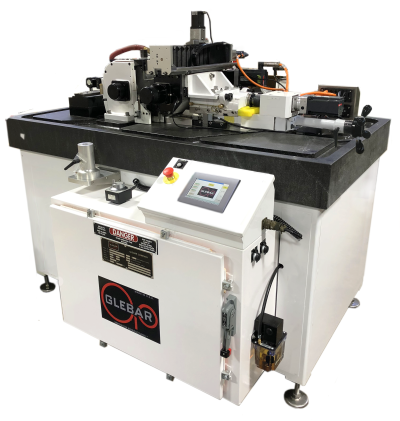
Driven by its solution-oriented leadership, and skilled engineering staff, precision centerless grinding solution provider Glebar Company developed a new machine platform capable of processing carbide cutting blanks. Noticing market studies that indicated a healthy growth cycle in the specialty carbide cutting tool industry, especially in the aerospace sector, Glebar went to work innovating a new manufacturing process.
Grinding carbide is challenging as it is one of the hardest materials on Earth, ranging in hardness between 65 and 85 Rc. After sintering, carbide has a rough surface finish and chips easily making it difficult to grind.
To grind carbide parts, an operator will thrufeed a part across a narrow grinding wheel, applying more pressure wearing the wheel out faster. Due to the narrow work wheel, multiple passes are required occupying skilled operators and accelerating wear on the grinding machine and on the tooling. Legacy machines are extremely large in comparison to the small diameter of the carbide cutting blanks and take up valuable square footage on the manufacturing floor.
Glebar was challenged to deliver a process to grind carbide cutting blanks. Following a customer’s spec, the processes needed to maintain cylindricity of 2 microns over a 4” long part. Glebar delivered with its innovative GT-610 EZ Centerless Grinding Machine. The GT-610 EZ excels at thrufeed grinding hard materials such as steel, carbide, PCD inserts, and technical ceramics while operating on a much smaller footprint than the competition.
“The GT-610 EZ uses a proven twin grip 8-5/8" wide grinding wheel setup spreading the material removal over a longer span which results in higher throughput, less aggressive approach reducing chipping, and a smoother overall surface finish ” explained John Bannayan, Chief Technical Officer at Glebar Company.
Another unique feature of the GT-610 EZ is its ability to produce G-ratios that can exceed those of machines twice its size. When running super abrasives, a variable frequency drive on the work wheel spindle is available to increase wheel surface feet.
In this application, on the 0.750” diameter carbide blanks the roughing operation removed 0.012” and the finish pass removed 0.003” improving on the 2 Rz surface finish requirement. Glebar met the customer’s cylindricity spec of 2 microns over the 4” long part. The straightness and roundness of the parts were sub 1.5 microns.
Contact Details
Related Glossary Terms
- centerless grinding
centerless grinding
Grinding operation in which the workpiece rests on a knife-edge support, rotates through contact with a regulating or feed wheel and is ground by a grinding wheel. This method allows grinding long, thin parts without steady rests; also lessens taper problems. Opposite of cylindrical grinding. See cylindrical grinding; grinding.
- ceramics
ceramics
Cutting tool materials based on aluminum oxide and silicon nitride. Ceramic tools can withstand higher cutting speeds than cemented carbide tools when machining hardened steels, cast irons and high-temperature alloys.
- grinding
grinding
Machining operation in which material is removed from the workpiece by a powered abrasive wheel, stone, belt, paste, sheet, compound, slurry, etc. Takes various forms: surface grinding (creates flat and/or squared surfaces); cylindrical grinding (for external cylindrical and tapered shapes, fillets, undercuts, etc.); centerless grinding; chamfering; thread and form grinding; tool and cutter grinding; offhand grinding; lapping and polishing (grinding with extremely fine grits to create ultrasmooth surfaces); honing; and disc grinding.
- grinding machine
grinding machine
Powers a grinding wheel or other abrasive tool for the purpose of removing metal and finishing workpieces to close tolerances. Provides smooth, square, parallel and accurate workpiece surfaces. When ultrasmooth surfaces and finishes on the order of microns are required, lapping and honing machines (precision grinders that run abrasives with extremely fine, uniform grits) are used. In its “finishing” role, the grinder is perhaps the most widely used machine tool. Various styles are available: bench and pedestal grinders for sharpening lathe bits and drills; surface grinders for producing square, parallel, smooth and accurate parts; cylindrical and centerless grinders; center-hole grinders; form grinders; facemill and endmill grinders; gear-cutting grinders; jig grinders; abrasive belt (backstand, swing-frame, belt-roll) grinders; tool and cutter grinders for sharpening and resharpening cutting tools; carbide grinders; hand-held die grinders; and abrasive cutoff saws.
- grinding wheel
grinding wheel
Wheel formed from abrasive material mixed in a suitable matrix. Takes a variety of shapes but falls into two basic categories: one that cuts on its periphery, as in reciprocating grinding, and one that cuts on its side or face, as in tool and cutter grinding.
- hardness
hardness
Hardness is a measure of the resistance of a material to surface indentation or abrasion. There is no absolute scale for hardness. In order to express hardness quantitatively, each type of test has its own scale, which defines hardness. Indentation hardness obtained through static methods is measured by Brinell, Rockwell, Vickers and Knoop tests. Hardness without indentation is measured by a dynamic method, known as the Scleroscope test.
- polycrystalline diamond ( PCD)
polycrystalline diamond ( PCD)
Cutting tool material consisting of natural or synthetic diamond crystals bonded together under high pressure at elevated temperatures. PCD is available as a tip brazed to a carbide insert carrier. Used for machining nonferrous alloys and nonmetallic materials at high cutting speeds.
- sintering
sintering
Bonding of adjacent surfaces in a mass of particles by molecular or atomic attraction on heating at high temperatures below the melting temperature of any constituent in the material. Sintering strengthens and increases the density of a powder mass and recrystallizes powder metals.

